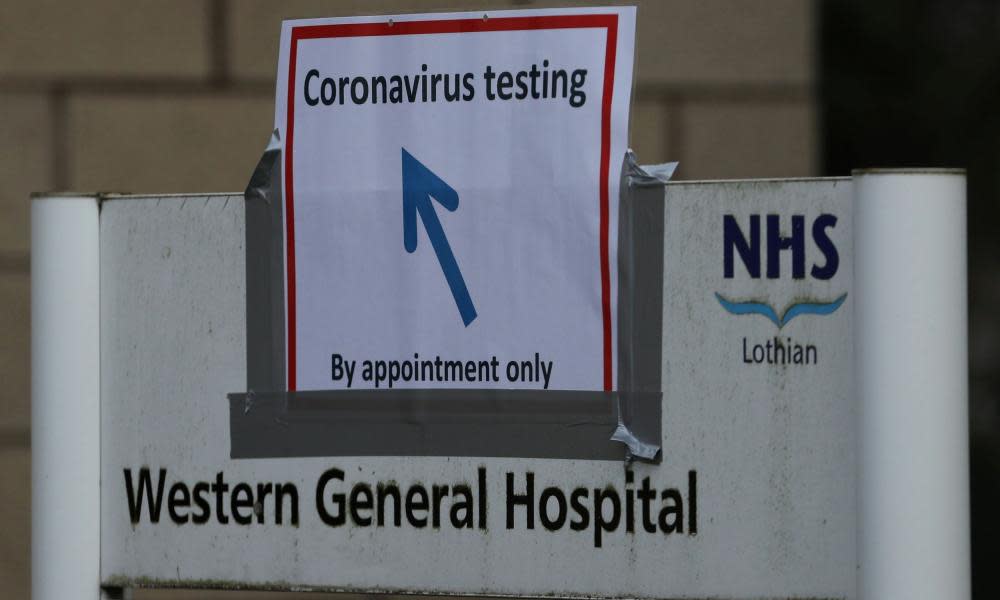Coronavirus spread on Edinburgh ward after patient's transfer

It started with a routine admission from another hospital on Friday 3 April. An elderly patient came on to ward 15 of the Western General in Edinburgh with a mild cough, but not the kind of cough to worry the medical staff in charge.
Two days later the woman’s cough became more severe and a fever set in. The staff decided to test her for Covid-19, and a day later the result came back: positive.
The nurses who had treated the patient without any face protection for two days were ordered to wear full PPE when they entered her single room, but it seems the virus had already spread widely among medics and support staff. Within a week it had affected the entire ward.
By Tuesday 14 April, sources say, more than 24 members of medical staff who worked on ward 15 were off work with confirmed or suspected Covid-19, and more than 20 patients were also affected, either testing positive for the virus or showing worrying symptoms.
All of the ward’s nurses, four doctors, and physiotherapists and support staff were affected. “Over the following nine days, patients and staff dropped like flies as Covid-19 swept the ward,” said one source. “Masks were finally approved for constant use on Thursday 9 April, but it was too late.”
NHS Lothian, which runs the Western General, insists the patient did not have symptoms “indicative of Covid-19” when she arrived on ward 15. It confirmed that the ward was hit by a serious outbreak of the virus, with 18 members of staff and 16 patients testing positive. Those staff went off work sick, as did others whose tests came back negative, and the patients were transferred to specialist coronavirus wards for treatment.
Dr Tracey Gillies, NHS Lothian’s medical director, told the Guardian that staff scrupulously followed the policy in force across the NHS at the time. In early April there was no policy on screening patients being transferred between hospitals.
“The ward was kept under strict observation and staff had access to and wore the correct PPE which was appropriate to the situation. A further two cases were recorded on the ward and it was closed to further admission [on 10 April],” she said.
“As this occurred during a period of sustained community transmission, it is not possible to know the source involved in each individual case, nor the length of time someone has carried the infection before becoming symptomatic.”
Gillies said none of those infected in the outbreak were transferred to high-dependency or intensive care wards, none of the staff needed hospitalisation and there were no fatalities.
In March the ward had been redesignated as an orthopaedics ward earmarked for elderly patients including those with dementia, as the NHS rapidly reorganised itself to cope with a feared flood of Covid-19 cases. Official data shows that 76% of the Covid-19 deaths in Scotland have occurred among over-75s.
At the start of the pandemic, the Western had put in train a well-rehearsed emergency plan: it was split into a green, non-Covid zone and a cordoned-off red zone dedicated to treating coronavirus 19 patients. In the red zone, face protection and full PPE were standard equipment for all staff.
The Western is the base for eastern Scotland’s regional infectious diseases unit. It set up Scotland’s first drive-through testing centre for health workers, and community testing and track and trace teams. Its specialists were consulted by hospitals in northern Italy as the outbreak grew there.
Yet, according to the Guardian’s sources, staff in ward 15 struggled to get the correct PPE, often “scrounging supplies” from other wards. There were inadequate stocks of the correct grade of mask – type 2Rs – and other essentials on the ward for treating Covid-19 patients, two sources said.
“We had problems with all stock, not just PPE,” said one source. “Bed linen, bed pans etc all ran out at various times. There was no universal testing – not policy. Policy was to only test patients who were symptomatic. No staff testing initially, just isolate on symptoms.”
On 15 April, 12 days after the coughing patient arrived, ward 15 was shut down and deep-cleaned.
NHS Lothian denied there were any shortages at the Western and insisted staff always knew where and how to find the correct supplies. It said delivery schedules changed but the hospital always had the correct stocks.
Gillies said NHS Lothian had learned from the incident and other experiences. It implemented guidance introduced by the Scottish government on 29 April recommending that all patients over 70 are tested on admission and every four days, irrespective of symptoms.
“Recommendations for staff testing applied only to those with symptoms and, as such, staff were not tested at the same time that the patient developed symptoms. This remains the current national guidance,” she said.
Ros Shaw, a senior officer with the Royal College of Nurses Scotland, said: “From the outset of this pandemic the RCN has been clear that adequate supplies of PPE and priority testing for staff are essential to protect our members and the patients they care for.
“This example of transmission within a non-Covid-19 ward highlights the need for routine testing and adequate PPE throughout Scotland’s health and care facilities. We expect lessons to be learned and this learning to be incorporated into the planning for the resumption of NHS services.”
Neil Findlay, a Labour MSP for the Lothians who campaigns on healthcare, said: “This story encapsulates very succinctly the situation that emerged in many wards during the early weeks of this crisis.
“It would be credible for NHS Lothian to accept that there were failings, not just at a local level but across the whole country in the way Covid-19 was managed at the time. Instead, what we have are repeated denials that these serious problems existed. We will never learn lessons if we don’t face up to that reality.”

 Yahoo News
Yahoo News 
